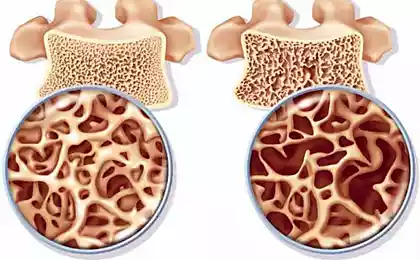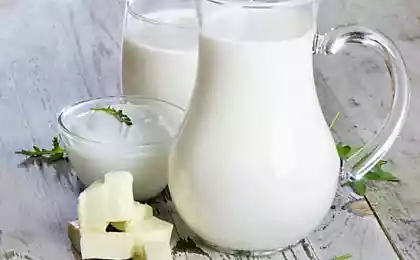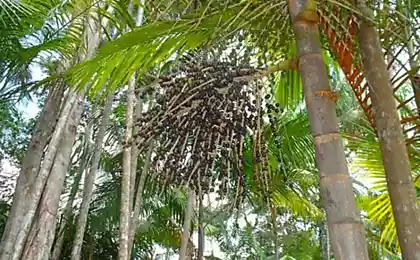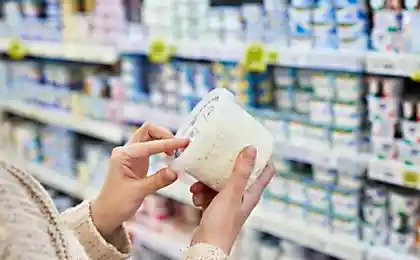531
Osteoporosis: What you need to do to prevent it
What is osteoporosis? Isn't that bone fragility that is so common in older women?
Yes, it is, but not immune from it and older men. Osteoporosis, which literally means porous or sparse, the bones — a disease in which the bone structure is modified so that a much increased risk of fracture. This is a serious medical problem faced by 25 million Americans at fault and that annually 1.3 million broken bones. Every second woman and every fifth man after 65 years, see a doctor due to fracture bones, break them precisely because of osteoporosis.
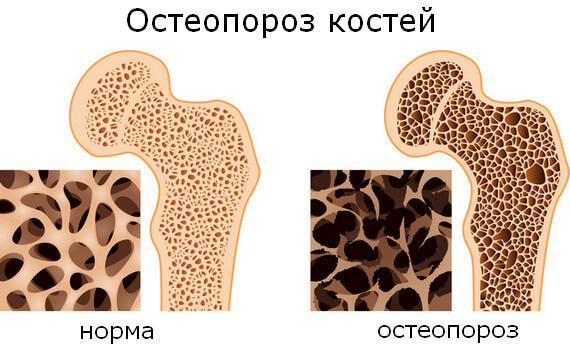
Of course, this is related not only to back: fractures of the hip, wrist, forearm and lower leg — however, and spine, too — quite often in older people not only during the fall, but then, for example, when they try to access too tightly closed window.
The severity of these fractures depends on the age. According to a study by Steven Hohler, about half of women older than 80 years had signs of broken ribs and vertebrae. Osteoporosis that is responsible for the majority of the so-called compression fractures, although sometimes the same thing happens with the bones affected by cancer.
Hence the back pain?
In General, Yes. When there is a fracture of a vertebra, the surrounding muscles go into a state of spasm, and painful it is. When the bone has fused, usually with the right conservative treatment — bed rest and pain medication, the pain gradually goes away. However, people with osteoporosis often experience pain and without fractures, as their illness compresses and distorts the spine, clenching his lungs and causing breathing difficulties.
Why is osteoporosis?
No one until the end and do not know, but we know that the decisive factor is age. With age bones degrade, and after 35 years, the body begins to produce less of the substance for building new bone tissue (a process continuously occurring in the body throughout life). The bones become friable, lose their density and this will become more brittle.
Why is osteoporosis more often in women than in men?
In women, bone tissue is degraded more rapidly by 2% annually after menopause, that is, the completion of the childbearing age, when sharply declining levels of estrogen, the female sex hormones in the body.
Moreover, women do not have to be old to make it happen. Those who have early menopause or some reason there is amenorrhea (the absence of menstruation), are also candidates in patients with osteoporosis.
Why is amenorrhea? It can occur in athletes as the result of resistance training (enough to run more than 20 miles a week); can be caused by eating disorders such as bulimia (painfully heightened sense of hunger) or anorexia nervosa — complete loss of appetite.
Any number of missed cycles can serve as a Wake signal that is output from your bones calcium. Finally, women are more likely to suffer from osteoporosis than men because they have baseline bone mass compared to body weight, 30% less than men.

Are there other risk factors for osteoporosis?
You can name a few important factors.
How do I know if I have osteoporosis?
It usually develops over many years, and nobody knows about it until then, until a bone fracture. As the disease develops, you can catch only one alarm signal — an exaggerated kyphosis, or rounding of the back known as a "widow's hump". People with this defect become noticeably shorter; however, this is partly true of all older people, as their intervertebral discs contain less amount of moisture.
Are there any special tests for osteoporosis?
If there is sufficient evidence (including x-rays) to assume you have osteoporosis, your doctor may order a diagnostic procedure called "bone densimetry". Using a safe and painless x-ray examination, the doctor checks the density of your bones and compares it with the norm for your age, gender and race.
Often such tests are performed in women during menopause, to learn the "background" density of their bones, — this information will be useful in the future. If the doctor finds that you have excessively low bone mass, he may order additional testing to identify possibly other diseases that destroy your bone, such as osteomalacia or low levels of vitamin D in the body.
What to do to prevent osteoporosis?
You can't prevent it. Everyone eventually gets sick of them, if you live enough years, because the bones of each person will eventually lose density.
However, you can do a lot in the course of life that he started to develop as late as possible and that you avoid fractures — basically, by "storing" bone, i.e. bone augmentation before you get old. This is achieved through physical training, good nutrition and other healthy habits.

You have to "go on a diet, rich in calcium? Should I drink more milk?
Yes; or if you're afraid of getting fat, — consume calcium in any other form, including low-fat yogurt, products such as broccoli cabbage and other greenery, and special supplements.
Depending on your age and other factors, you require some amount of calcium. National Institute of health recommends the following daily intake of calcium.
• Individuals aged 11 to 24 years, 1.2 g
• Pregnant and lactating women up to 19 years — 2.0 g
• Pregnant and lactating women 19 years and older — 1.4 g
• Women before menopause — 1.0 g
• Women not taking estrogen, menopausal — 1.5 g
In women taking estrogen in menopause — 1.0 g
• Middle-aged men— 1.0 g
To make it clearer we will add that in a glass of milk contains about 300 mg (0.3 grams) of calcium.
Prevention of cervical lumbago—exercises for ChelnokovaHow to NEVER get sick: Kinesiological technique of self-help "3 strike"
The fact that calcium is needed for bones, I understand, but why take vitamin D? And how much should be taken?
Vitamin D helps your body absorb calcium. Administration food and drug administration (APM) recommends taking vitamin D in quantities of 400 ME (International EDI - down) daily. Glass of whole milk contains 100 ME, therefore, four cups of milk a day can give you your daily dose of both calcium and vitamin D.
If you do not drink milk, you should eat liver, eggs and oily fish — all of these products have vitamin D. alternatively, can make vitamin preparations. However, first consult your doctor, because vitamin D in large doses can be toxic.
C. Salmans
P. S. And remember, only by changing their consumption — together we change the world! ©
Source: vk.com/wall-23903469?offset=4140&w=wall-23903469_1286%2Fall
Yes, it is, but not immune from it and older men. Osteoporosis, which literally means porous or sparse, the bones — a disease in which the bone structure is modified so that a much increased risk of fracture. This is a serious medical problem faced by 25 million Americans at fault and that annually 1.3 million broken bones. Every second woman and every fifth man after 65 years, see a doctor due to fracture bones, break them precisely because of osteoporosis.

Of course, this is related not only to back: fractures of the hip, wrist, forearm and lower leg — however, and spine, too — quite often in older people not only during the fall, but then, for example, when they try to access too tightly closed window.
The severity of these fractures depends on the age. According to a study by Steven Hohler, about half of women older than 80 years had signs of broken ribs and vertebrae. Osteoporosis that is responsible for the majority of the so-called compression fractures, although sometimes the same thing happens with the bones affected by cancer.
Hence the back pain?
In General, Yes. When there is a fracture of a vertebra, the surrounding muscles go into a state of spasm, and painful it is. When the bone has fused, usually with the right conservative treatment — bed rest and pain medication, the pain gradually goes away. However, people with osteoporosis often experience pain and without fractures, as their illness compresses and distorts the spine, clenching his lungs and causing breathing difficulties.
Why is osteoporosis?
No one until the end and do not know, but we know that the decisive factor is age. With age bones degrade, and after 35 years, the body begins to produce less of the substance for building new bone tissue (a process continuously occurring in the body throughout life). The bones become friable, lose their density and this will become more brittle.
Why is osteoporosis more often in women than in men?
In women, bone tissue is degraded more rapidly by 2% annually after menopause, that is, the completion of the childbearing age, when sharply declining levels of estrogen, the female sex hormones in the body.
Moreover, women do not have to be old to make it happen. Those who have early menopause or some reason there is amenorrhea (the absence of menstruation), are also candidates in patients with osteoporosis.
Why is amenorrhea? It can occur in athletes as the result of resistance training (enough to run more than 20 miles a week); can be caused by eating disorders such as bulimia (painfully heightened sense of hunger) or anorexia nervosa — complete loss of appetite.
Any number of missed cycles can serve as a Wake signal that is output from your bones calcium. Finally, women are more likely to suffer from osteoporosis than men because they have baseline bone mass compared to body weight, 30% less than men.

Are there other risk factors for osteoporosis?
You can name a few important factors.
- Heredity. Remember your family history of fractures, graceful, fine-boned addition of your ancestors, their slim, very white skin; in addition, the presence of Caucasian or Asian blood place you at risk. Genetics may explain why some women even at a young age is osteoporosis well before menopause.
- Nutrition and lifestyle. Monotonous, poor vitamin D and calcium nutrition, a sedentary lifestyle often lead to osteoporosis — as well as Smoking and drinking alcoholic beverages.
- Other diseases and their treatment. Osteoporosis can often be the consequence of some medications, including steroids, and certain diseases. For example, when enlargement of the thyroid gland, accompanied by its increased activity, calcium is derived from hard bones and can develop premature osteoporosis.
How do I know if I have osteoporosis?
It usually develops over many years, and nobody knows about it until then, until a bone fracture. As the disease develops, you can catch only one alarm signal — an exaggerated kyphosis, or rounding of the back known as a "widow's hump". People with this defect become noticeably shorter; however, this is partly true of all older people, as their intervertebral discs contain less amount of moisture.
Are there any special tests for osteoporosis?
If there is sufficient evidence (including x-rays) to assume you have osteoporosis, your doctor may order a diagnostic procedure called "bone densimetry". Using a safe and painless x-ray examination, the doctor checks the density of your bones and compares it with the norm for your age, gender and race.
Often such tests are performed in women during menopause, to learn the "background" density of their bones, — this information will be useful in the future. If the doctor finds that you have excessively low bone mass, he may order additional testing to identify possibly other diseases that destroy your bone, such as osteomalacia or low levels of vitamin D in the body.
What to do to prevent osteoporosis?
You can't prevent it. Everyone eventually gets sick of them, if you live enough years, because the bones of each person will eventually lose density.
However, you can do a lot in the course of life that he started to develop as late as possible and that you avoid fractures — basically, by "storing" bone, i.e. bone augmentation before you get old. This is achieved through physical training, good nutrition and other healthy habits.

You have to "go on a diet, rich in calcium? Should I drink more milk?
Yes; or if you're afraid of getting fat, — consume calcium in any other form, including low-fat yogurt, products such as broccoli cabbage and other greenery, and special supplements.
Depending on your age and other factors, you require some amount of calcium. National Institute of health recommends the following daily intake of calcium.
• Individuals aged 11 to 24 years, 1.2 g
• Pregnant and lactating women up to 19 years — 2.0 g
• Pregnant and lactating women 19 years and older — 1.4 g
• Women before menopause — 1.0 g
• Women not taking estrogen, menopausal — 1.5 g
In women taking estrogen in menopause — 1.0 g
• Middle-aged men— 1.0 g
To make it clearer we will add that in a glass of milk contains about 300 mg (0.3 grams) of calcium.
Prevention of cervical lumbago—exercises for ChelnokovaHow to NEVER get sick: Kinesiological technique of self-help "3 strike"
The fact that calcium is needed for bones, I understand, but why take vitamin D? And how much should be taken?
Vitamin D helps your body absorb calcium. Administration food and drug administration (APM) recommends taking vitamin D in quantities of 400 ME (International EDI - down) daily. Glass of whole milk contains 100 ME, therefore, four cups of milk a day can give you your daily dose of both calcium and vitamin D.
If you do not drink milk, you should eat liver, eggs and oily fish — all of these products have vitamin D. alternatively, can make vitamin preparations. However, first consult your doctor, because vitamin D in large doses can be toxic.
C. Salmans
P. S. And remember, only by changing their consumption — together we change the world! ©
Source: vk.com/wall-23903469?offset=4140&w=wall-23903469_1286%2Fall








